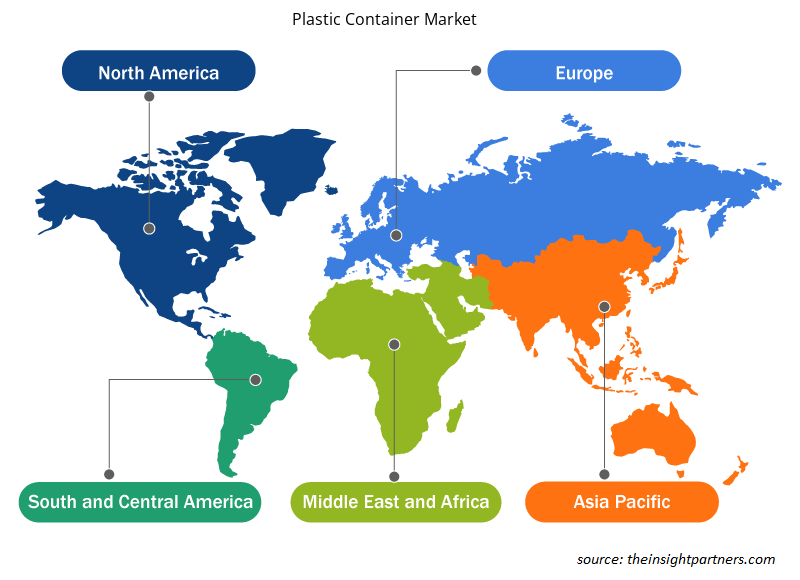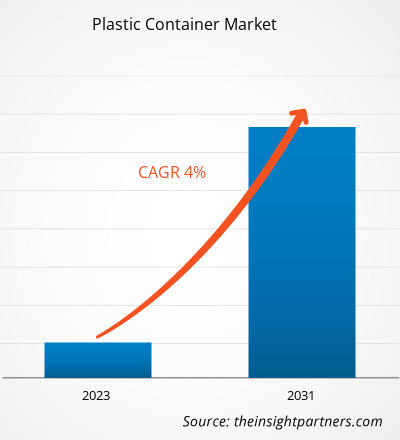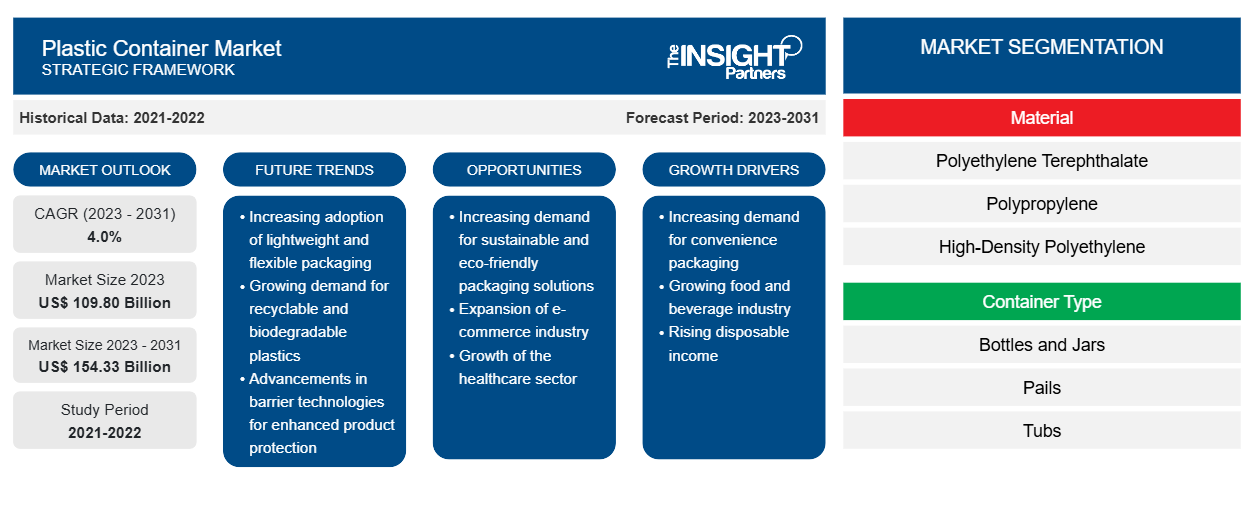من المتوقع أن يصل حجم سوق الحاويات البلاستيكية إلى 154.33 مليار دولار أمريكي بحلول عام 2031 من 109.80 مليار دولار أمريكي في عام 2023. ومن المتوقع أن يسجل السوق معدل نمو سنوي مركب بنسبة 4.0٪ في الفترة 2023-2031. ومن المرجح أن يظل الطلب المتزايد من الصناعات النهائية، بما في ذلك صناعات الأغذية والمشروبات ومستحضرات التجميل، أحد الاتجاهات الرئيسية لسوق الحاويات البلاستيكية.
تحليل سوق الحاويات البلاستيكية
تتعدد استخدامات الحاويات البلاستيكية وتتوافر بأحجام وأشكال وتصميمات مختلفة. وتُستخدم على نطاق واسع في تطبيقات مختلفة، بما في ذلك تخزين الأغذية، والنقل، وتنظيم الأدوات المنزلية، وتعبئة السلع الصناعية. وتجعل مرونة الحاويات البلاستيكية منها خيارًا شائعًا لتلبية احتياجات متنوعة، مما يزيد الطلب عليها عبر قطاعات متعددة. بالإضافة إلى ذلك، تتمتع الحاويات البلاستيكية بمقاومة فعالة للرطوبة والهواء، مما يجعلها خيارًا مثاليًا لتغليف الأطعمة الطازجة للحفاظ على نضارة الطعام. وبالإضافة إلى هذه الصفات، فإن آليات الغلق السهلة لها حيوية للحفاظ على النظافة ومنع التلف. بالإضافة إلى ذلك، توفر الحاويات البلاستيكية بديلاً فعالاً من حيث التكلفة لمواد التغليف الأخرى مثل العبوات المعدنية ، والتي تمتد إلى المستهلكين. تساعد طبيعة الحاويات البلاستيكية خفيفة الوزن في تقليل تكاليف الشحن، مما يجعلها خيارًا مثاليًا للمستخدمين النهائيين. وبالتالي، فإنهم غالبًا ما يفضلون الحاويات البلاستيكية لتغليف السلع والمنتجات، مما يعزز الطلب على حاويات تخزين الأطعمة البلاستيكية في المنازل وصناعة الأغذية.
نظرة عامة على سوق الحاويات البلاستيكية
غالبًا ما يحتاج مصنعو منتجات العناية الشخصية ومستحضرات التجميل إلى مواد تغليف فريدة وممتعة من الناحية الجمالية لجذب المستهلكين. يمكن تشكيل الحاويات البلاستيكية بأشكال وأحجام وتصميمات مختلفة، مما يساعد المصنعين على إنتاج عبوات جمالية ومميزة. يعد توافر العبوات البلاستيكية بأشكال وأحجام مختلفة أمرًا حيويًا في صناعة العناية الشخصية ومستحضرات التجميل، حيث يكون عرض المنتج والعلامة التجارية أمرًا مهمًا.
قم بتخصيص هذا التقرير ليناسب متطلباتك
ستحصل على تخصيص لأي تقرير - مجانًا - بما في ذلك أجزاء من هذا التقرير، أو تحليل على مستوى الدولة، وحزمة بيانات Excel، بالإضافة إلى الاستفادة من العروض والخصومات الرائعة للشركات الناشئة والجامعات
-
احصل على أهم اتجاهات السوق الرئيسية لهذا التقرير.ستتضمن هذه العينة المجانية تحليلاً للبيانات، بدءًا من اتجاهات السوق وحتى التقديرات والتوقعات.
محركات وفرص سوق الحاويات البلاستيكية
الطلب المتزايد من صناعة المشروبات يعزز نمو سوق الحاويات البلاستيكية
توفر الحاويات البلاستيكية حلاً خفيف الوزن ومتينًا للتغليف، مما يجعلها مثالية لنقل المشروبات، مما يساعد على تقليل تكاليف الشحن والحد من مخاطر الكسر أثناء النقل. وهذا يضمن سلامة المنتج حتى التسليم. علاوة على ذلك، تشجع الحاويات البلاستيكية على تصميمات التغليف المبتكرة. يستخدم مصنعو الحاويات البلاستيكية أشكالًا وألوانًا وعلامات مختلفة لتحسين المظهر البصري للمنتجات. يعد التميز على أرفف المتاجر وجذب العملاء أمرًا مهمًا في مشهد صناعة المشروبات شديد التنافسية. بالإضافة إلى ذلك، غالبًا ما تكون الحاويات البلاستيكية مصنوعة من مواد قابلة لإعادة التدوير، حيث يعمل العديد من المستخدمين النهائيين على تعزيز الاستدامة من خلال استخدام البلاستيك المعاد تدويره لتغليف المنتجات. يشجع الوعي المتزايد بالتأثير السلبي للبلاستيك الدقيق على البيئة وصحة الإنسان مصنعي المشروبات على تبني حلول تغليف صديقة للبيئة.
انتشار صناعة التجارة الإلكترونية
إن كفاءة وأمان مواد التغليف أمران بالغي الأهمية بالنسبة لشركات التجارة الإلكترونية. يعتمد المستهلكون على المنصات عبر الإنترنت لشراء منتجات مختلفة، ويتطلب المصنعون وتجار التجزئة تغليفًا مناسبًا لتخزين هذه المنتجات وحمايتها وتسليمها. إن راحة التسوق عبر الإنترنت تعزز نمو التجارة الإلكترونية، وهو محرك مهم للطلب المتزايد على الحاويات البلاستيكية. بفضل تنوعها ومتانتها، أصبحت الحاويات البلاستيكية مادة تغليف شائعة لضمان النقل الآمن للمنتجات. يساعد الوزن الخفيف وتوافر الحاويات البلاستيكية بأحجام وأشكال مختلفة في تحسين مساحة الشحن والتخزين. وهذا يساعد الشركات على تقليل تكاليف الشحن ويساعد في استخدام المساحة بشكل فعال.
تقرير تحليل تجزئة سوق الحاويات البلاستيكية
إن القطاعات الرئيسية التي ساهمت في اشتقاق تحليل سوق الحاويات البلاستيكية هي المادة ونوع الحاوية والاستخدام النهائي.
- بناءً على المواد، يتم تقسيم السوق إلى بولي إيثيلين تيريفثالات، وبولي بروبيلين، وبولي إيثيلين عالي الكثافة، وبولي إيثيلين منخفض الكثافة، وغيرها. احتلت شريحة بولي إيثيلين تيريفثالات حصة سوقية أكبر في عام 2023.
- من حيث نوع الحاوية، ينقسم سوق الحاويات البلاستيكية إلى زجاجات وبرطمانات، ودلاء، وأحواض، وأكواب وأوعية، وغيرها. احتلت شريحة الزجاجات والبرطمانات حصة سوقية أكبر في عام 2023.
- على أساس الاستخدام النهائي، ينقسم السوق إلى المشروبات والأغذية والأدوية والعناية الشخصية ومستحضرات التجميل وغيرها. احتل قطاع المشروبات حصة سوقية أكبر في عام 2023.
تحليل حصة سوق الحاويات البلاستيكية حسب المنطقة الجغرافية
ينقسم النطاق الجغرافي لتقرير سوق الحاويات البلاستيكية بشكل أساسي إلى خمس مناطق: أمريكا الشمالية، ومنطقة آسيا والمحيط الهادئ، وأوروبا، والشرق الأوسط وأفريقيا، وأمريكا الجنوبية والوسطى.
أدى النمو السكاني السريع والتحضر في منطقة آسيا والمحيط الهادئ إلى زيادة استهلاك الأطعمة والمشروبات المعبأة. ونتيجة لذلك، هناك حاجة أكبر لمواد التعبئة والتغليف، حيث أصبحت الحاويات البلاستيكية خيارًا شائعًا نظرًا لراحتها وبأسعار معقولة. بالإضافة إلى ذلك، أدى النمو الاقتصادي في العديد من دول آسيا والمحيط الهادئ إلى تعزيز الدخول المتاحة، مما أدى إلى تغييرات في تفضيلات المستهلكين. أصبح المستهلكون الآن أكثر ميلاً لشراء الأطعمة والمشروبات الجاهزة. إن عامل الراحة، مثل الأغطية القابلة لإعادة الإغلاق والتغليف خفيف الوزن، يحرك سوق الحاويات البلاستيكية. علاوة على ذلك، تشهد منطقة آسيا والمحيط الهادئ طفرة في صناعة التجارة الإلكترونية، والتي تعتمد بشكل كبير على حلول التعبئة والتغليف الفعالة. الحاويات البلاستيكية، مثل زجاجات البولي إيثيلين تيرفثاليت للمشروبات وحاويات الطعام المختلفة، مناسبة تمامًا للبيع بالتجزئة عبر الإنترنت لأنها متينة وخفيفة الوزن وتقلل من خطر تلف المنتج أثناء الشحن.
رؤى إقليمية حول سوق الحاويات البلاستيكية
لقد قام المحللون في Insight Partners بشرح الاتجاهات والعوامل الإقليمية المؤثرة على سوق الحاويات البلاستيكية طوال فترة التوقعات بشكل شامل. يناقش هذا القسم أيضًا قطاعات سوق الحاويات البلاستيكية والجغرافيا في جميع أنحاء أمريكا الشمالية وأوروبا ومنطقة آسيا والمحيط الهادئ والشرق الأوسط وأفريقيا وأمريكا الجنوبية والوسطى.

- احصل على البيانات الإقليمية المحددة لسوق الحاويات البلاستيكية
نطاق تقرير سوق الحاويات البلاستيكية
| سمة التقرير | تفاصيل |
|---|---|
| حجم السوق في عام 2023 | 109.80 مليار دولار أمريكي |
| حجم السوق بحلول عام 2031 | 154.33 مليار دولار أمريكي |
| معدل النمو السنوي المركب العالمي (2023 - 2031) | 4.0% |
| البيانات التاريخية | 2021-2022 |
| فترة التنبؤ | 2023-2031 |
| القطاعات المغطاة |
حسب المادة
|
| المناطق والدول المغطاة |
أمريكا الشمالية
|
| قادة السوق وملفات تعريف الشركات الرئيسية |
|
كثافة اللاعبين في سوق الحاويات البلاستيكية: فهم تأثيرها على ديناميكيات الأعمال
يشهد سوق حاويات البلاستيك نموًا سريعًا، مدفوعًا بالطلب المتزايد من المستخدم النهائي بسبب عوامل مثل تفضيلات المستهلكين المتطورة والتقدم التكنولوجي والوعي المتزايد بفوائد المنتج. ومع ارتفاع الطلب، تعمل الشركات على توسيع عروضها والابتكار لتلبية احتياجات المستهلكين والاستفادة من الاتجاهات الناشئة، مما يؤدي إلى زيادة نمو السوق.
تشير كثافة اللاعبين في السوق إلى توزيع الشركات أو المؤسسات العاملة في سوق أو صناعة معينة. وهي تشير إلى عدد المنافسين (اللاعبين في السوق) الموجودين في مساحة سوق معينة نسبة إلى حجمها أو قيمتها السوقية الإجمالية.
الشركات الرئيسية العاملة في سوق الحاويات البلاستيكية هي:
- شركة أمكور المحدودة
- شركة سونوكو للمنتجات
- شركة بيري العالمية
- شركة بلاستيباك القابضة المحدودة
- ALPLA Werke Alwin Lehner GmbH and Co KG
- شركة جراهام للتغليف
إخلاء المسؤولية : الشركات المذكورة أعلاه ليست مرتبة بأي ترتيب معين.

- احصل على نظرة عامة على أهم اللاعبين الرئيسيين في سوق الحاويات البلاستيكية
أخبار سوق الحاويات البلاستيكية والتطورات الأخيرة
يتم تقييم سوق الحاويات البلاستيكية من خلال جمع البيانات النوعية والكمية بعد البحث الأولي والثانوي، والتي تتضمن منشورات الشركات المهمة وبيانات الجمعيات وقواعد البيانات. فيما يلي قائمة بالتطورات في سوق الحاويات البلاستيكية والاستراتيجيات:
- لقد حققت المهارات الفنية والتصنيعية لشركة Berry Global تقدمًا كبيرًا في مجال تعبئة السوائل الخطرة. أطلقت الشركة الآن أول حاويات بسعة 20 و 25 لترًا تحتوي على 35٪ من المواد المعاد تدويرها، والتي حصلت على موافقة الأمم المتحدة لنقل البضائع الخطرة لخمسة من السوائل النموذجية الستة في تقييم الأمم المتحدة. بالإضافة إلى موافقة الأمم المتحدة الحالية للمياه، حصلت الحاويات الجديدة أيضًا على موافقة على محلول الترطيب وحمض الأسيتيك والروح البيضاء وأسيتات N-butyl. إن إدخال هذه الحاويات الجديدة في مجموعة Optimum الشهيرة للشركة سيدعم الشركات في تحقيق أهداف الاستدامة وتلبية مطالب المستهلكين لحلول تغليف أكثر استدامة. كما سيساعد الشركات على الامتثال للتشريعات القادمة التي تغطي الحد الأدنى المطلوب من المواد المعاد تدويرها في العبوة. (المصدر: Berry Global Inc، بيان صحفي، 2023)
تقرير سوق الحاويات البلاستيكية والتغطية والنتائج المتوقعة
يوفر تقرير "حجم سوق الحاويات البلاستيكية والتوقعات (2021-2031)" تحليلاً مفصلاً للسوق يغطي المجالات التالية:
- حجم السوق والتوقعات على المستويات العالمية والإقليمية والوطنية لجميع قطاعات السوق الرئيسية التي يغطيها النطاق
- ديناميكيات السوق مثل المحركات والقيود والفرص الرئيسية
- الاتجاهات المستقبلية الرئيسية
- تحليل مفصل لقوى بورتر الخمس ونقاط القوة والضعف والفرص والتهديدات
- تحليل السوق العالمي والإقليمي الذي يغطي اتجاهات السوق الرئيسية واللاعبين الرئيسيين واللوائح والتطورات الأخيرة في السوق
- تحليل المشهد الصناعي والمنافسة الذي يغطي تركيز السوق، وتحليل خريطة الحرارة، واللاعبين البارزين، والتطورات الأخيرة
- ملفات تعريف الشركة التفصيلية
- التحليل التاريخي (سنتان)، سنة الأساس، التوقعات (7 سنوات) مع معدل النمو السنوي المركب
- تحليل PEST و SWOT
- حجم السوق والقيمة / الحجم - عالمي، إقليمي، بلد
- الصناعة والمنافسة
- مجموعة بيانات إكسل
التقارير الحديثة
تقارير ذات صلة
شهادات العملاء
سبب الشراء
- اتخاذ قرارات مدروسة
- فهم ديناميكيات السوق
- تحليل المنافسة
- رؤى العملاء
- توقعات السوق
- تخفيف المخاطر
- التخطيط الاستراتيجي
- مبررات الاستثمار
- تحديد الأسواق الناشئة
- تحسين استراتيجيات التسويق
- تعزيز الكفاءة التشغيلية
- مواكبة التوجهات التنظيمية























 احصل على عينة مجانية ل - سوق الحاويات البلاستيكية
احصل على عينة مجانية ل - سوق الحاويات البلاستيكية